Digital Connexion leads the way in data solutions, excelling in BFSI, Colocation, and Green Data Centers. Redefining connectivity for the digital era.https://digitalconnexion.com/
Don't wanna be here? Send us removal request.
Text
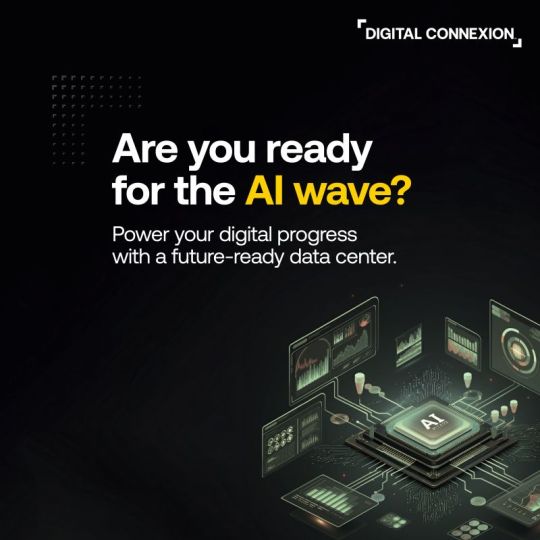
Future-Ready Data Centers for AI & Digital Growth | Digital Connexion
Accelerate your digital transformation with Digital Connexion’s future-ready data centers built to power the AI-driven world of tomorrow. Designed for scalability, energy efficiency, and seamless connectivity, our infrastructure helps enterprises stay ahead in a fast-evolving digital landscape.
0 notes
Text
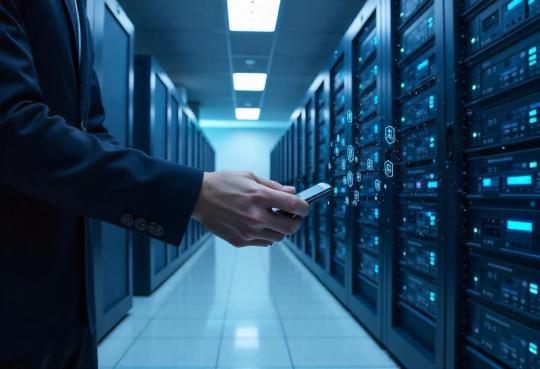
Why Businesses Trust Leading Data Center Providers in India for Mission-Critical Workloads
In today’s fast-paced digital economy, businesses are increasingly reliant on advanced data center services in India to maintain operational efficiency, scalability, and security. From startups to multinational corporations, organizations are recognizing the importance of partnering with a reliable data center provider in India to meet their unique IT needs.
What Are Data Center Services in India?
Data center services in India encompass a broad range of solutions designed to store, manage, and disseminate data for enterprises. These services include cloud computing, storage management, disaster recovery, colocation, and managed hosting. Indian data centers are now at the forefront of digital transformation, offering scalable and secure infrastructure that aligns with global standards.
Why Are Data Center Solutions in India Gaining Traction?
Data center solution in India has evolved with technological advancements and regulatory compliance. Solutions now include hybrid cloud setups, edge computing, and automation, making them ideal for companies looking for flexibility and cost-efficiency. Businesses benefit from seamless integration, robust network connectivity, and a secure IT ecosystem.
Who Are the Leading Data Center Providers in India?
Several top-tier data center provider in India have established state-of-the-art facilities in major cities. Companies such as Digital Connexion, CtrlS, STT GDC, and NTT Global Data Centers offer comprehensive solutions that support mission-critical workloads. These providers deliver redundancy, high uptime, and advanced cooling and power infrastructure.
How Do Businesses Benefit from Indian Data Centers?
Indian data centers offer benefits such as:
Geographic redundancy for business continuity
Lower latency through edge deployment
24/7 monitoring and support
Energy-efficient operations to meet sustainability goals
As a result, businesses enjoy improved reliability, reduced operational costs, and enhanced performance.
FAQs
Q: Why is it important to choose a reputed data center provider in India? A: A reputed provider ensures security, scalability, and uptime for mission-critical workloads, minimizing business disruptions.
Q: What makes Indian data center solutions unique? A: India offers a cost-effective, tech-forward infrastructure that supports global digital expansion and localized compliance.
Q: How do I choose the best data center services in India for my business? A: Consider factors such as location, compliance, security standards, scalability, and service support.
Q: What are the latest innovations in data center services in India? A: Providers are now integrating AI, edge computing, green energy solutions, and liquid cooling systems to enhance performance and sustainability.
Q: Are Indian data center providers aligned with global compliance standards? A: Yes, most leading providers adhere to certifications like ISO, SOC 2, and PCI DSS to ensure data safety and trust.
0 notes
Text
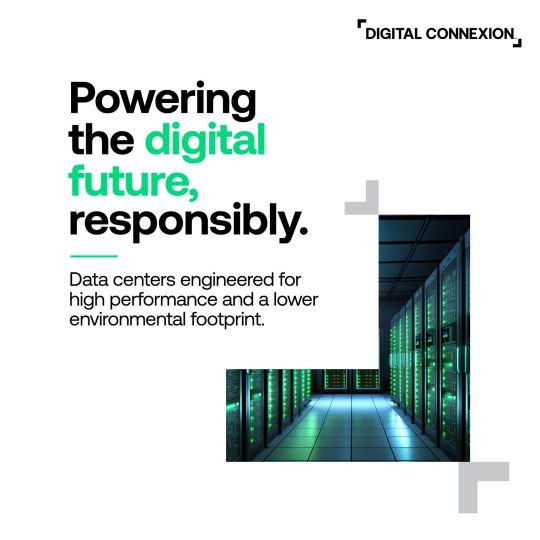
Sustainable Data Centers Built for Performance | Digital Connexion
At Digital Connexion, we believe in building a future that’s efficient and responsible. Our data centers are designed with sustainability at their core, leveraging clean energy solutions, high-efficiency cooling, and intelligent infrastructure to reduce environmental impact while delivering unmatched performance.
0 notes
Text

The Next Big Thing: Predictions for Data Center Innovations in 2025
As technology evolves, data centers remain at the heart of the digital transformation. The year 2025 is poised to bring groundbreaking innovations that will redefine how data centers operate, from integrating artificial intelligence to exploring quantum computing capabilities. With increasing demand for sustainable operations and new challenges on the horizon, data centers are set to undergo significant changes to meet the growing needs of businesses and consumers.
In this blog, we will explore the top trends, the impact of AI and quantum computing, the future of sustainability in data centers, and the challenges that lie ahead.
What Are the Top Data Center Trends for 2025?
1. Edge Computing Integration
As IoT devices proliferate and latency requirements tighten, edge computing will play a pivotal role in data center architectures.
Distributed data centers will process data closer to the source, reducing latency and improving performance.
2. AI-Powered Operations
Artificial intelligence will drive operational efficiency through predictive maintenance, dynamic workload balancing, and energy optimization.
AI will also enable smarter monitoring systems for real-time adjustments, reducing downtime and increasing productivity.
3. Rise of Modular Data Centers
Modular data centers offer a cost-effective and scalable solution, allowing businesses to expand infrastructure incrementally.
Prefabricated and containerized data centers will gain traction for rapid deployment in remote areas.
4. Liquid Cooling Technologies
Liquid cooling will replace traditional air-based systems in high-density environments, improving energy efficiency and reducing costs.
5. 5G-Driven Enhancements
The global rollout of 5G networks will demand data centers with higher bandwidth and ultra-low latency capabilities to handle real-time applications like autonomous vehicles and AR/VR.
How Will AI Shape the Future of Data Centers?
Artificial intelligence is revolutionizing data centers, offering unparalleled efficiency, automation, and insights.
1. Predictive Maintenance
AI-powered systems will predict hardware failures before they occur, reducing downtime and repair costs.
2. Dynamic Workload Optimization
AI algorithms will distribute workloads across servers dynamically, maximizing performance and minimizing energy consumption.
3. Security Enhancements
AI will detect and mitigate cyber threats in real time, offering robust protection against ransomware and DDoS attacks.
4. Intelligent Cooling
Machine learning models will analyze thermal data to optimize cooling systems, reducing power usage and operating costs.
5. Improved Decision-Making
AI analytics will provide actionable insights for data center managers, enabling data-driven decisions for infrastructure improvements.
What Role Will Quantum Computing Play in Data Centers?
Quantum computing, though in its early stages, promises to revolutionize data processing in data centers
1. Enhanced Computational Power
Quantum computers can solve complex problems exponentially faster than traditional systems, unlocking new possibilities for industries like cryptography, pharmaceuticals, and financial modeling.
2. Optimized Data Processing
Quantum algorithms will enable more efficient processing of large datasets, benefiting AI, big data, and machine learning applications.
3. Improved Data Encryption
Quantum technologies will enhance encryption standards, making data more secure against cyber threats.
4. Hybrid Environments
Data centers will integrate quantum computing with traditional systems to create hybrid environments for specialized workloads.
5. Long-Term Potential
While quantum computing is not yet ready for widespread deployment, data centers will invest in R&D to stay ahead of the curve.
What Is the Future of Sustainable Data Centers?
Sustainability is no longer optional; it’s a critical factor shaping the future of data centers.
1. Renewable Energy Adoption
Data centers will increasingly rely on solar, wind, and hydroelectric power to reduce their carbon footprints.
2. Carbon-Neutral Goals
Companies are committing to carbon neutrality, incorporating energy-efficient designs and offsetting emissions through renewable energy credits.
3. Advanced Cooling Solutions
Innovations like immersion cooling and liquid cooling will drastically reduce energy consumption, making data centers more sustainable.
4. Recyclable Materials
Data centers will use recyclable and eco-friendly materials in construction and equipment manufacturing.
5. AI-Driven Energy Optimization
AI will play a key role in reducing energy consumption by optimizing power usage across servers and cooling systems.
What Are the Biggest Challenges Data Centers Will Face in 2025?
1. Rising Energy Costs
As energy prices increase, data centers will face challenges in managing costs while maintaining efficiency.
2. Cybersecurity Threats
With the rise of sophisticated cyberattacks, data centers must invest in advanced security measures to protect sensitive information.
3. Scalability Concerns
Meeting the growing demands of IoT, AI, and 5G applications will require scalable solutions, which may strain existing infrastructure.
4. Regulatory Compliance
Adhering to evolving data sovereignty laws and environmental regulations will require significant investments in infrastructure and governance.
5. Talent Shortages
A lack of skilled professionals in fields like AI, quantum computing, and cybersecurity could hinder innovation and operational efficiency.
Conclusion: The data center industry is on the brink of transformative change, driven by innovations like AI, edge computing, quantum technology, and sustainable practices. These advancements will not only redefine how data centers operate but also enable businesses to meet the demands of an increasingly digital world.
As 2025 unfolds, data centers must prepare to navigate challenges like rising energy costs, regulatory pressures, and cybersecurity threats. By embracing cutting-edge technologies and sustainable practices, data centers can remain resilient and continue to power the digital economy.
0 notes
Text
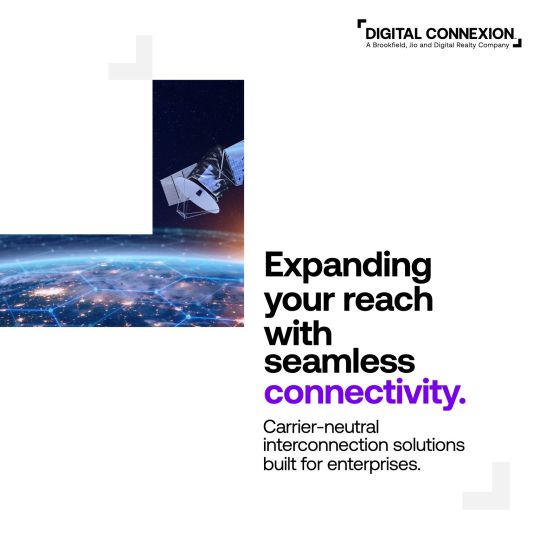
Colocation Data Center Provider in Chennai | Digital Connexion
In today’s interconnected world, seamless access to markets, partners, and opportunities is essential. Our carrier-neutral colocation and interconnection solutions ensure that your business stays connected securely, reliably, and at scale, so you can expand without limits.
0 notes
Text
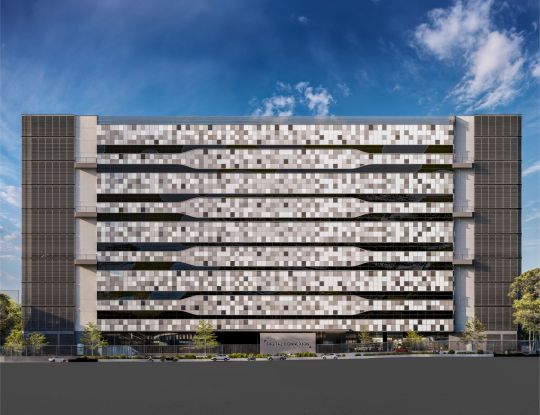
Digital Infrastructure Hub in Metro,Mumbai
BOM10 is rising in Chandivali, Metro Mumbai. Upon completion, it will deliver scalability, security, and seamless connectivity to India’s evolving digital landscape. Spanning across 2.1 acres, this 40MW facility shall support high-performance workloads with robust power, dense fiber connectivity, and direct subsea cable access for low-latency global data exchange.
With round-the-clock infrastructure and network monitoring, BOM10 will ensure unmatched reliability for mission-critical operations. Stay tuned for more updates as we build toward the future.
0 notes
Text
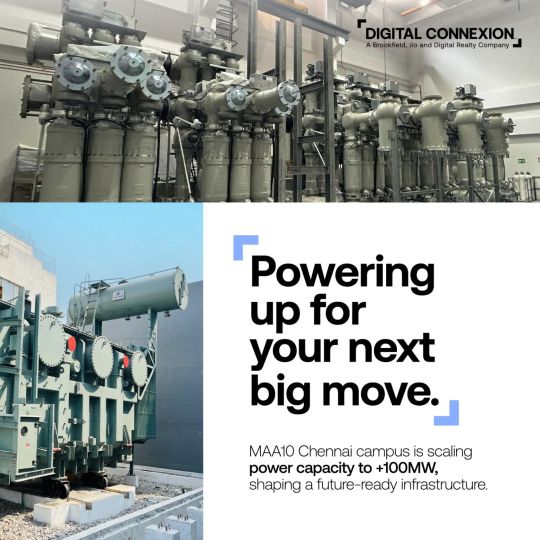
MAA10 Chennai Campus: Upgrading to 230kV GIS for +100MW Power Expansion
We are gearing up to start testing the 230kV GIS at MAA10 Chennai Campus, upgrading from 33kV to 230kV. This transformation will expand power availability from 12MW to +100MW, enabling organizations to scale IT workloads seamlessly. As Chennai strengthens its position as a leading data center hub, we are building the infrastructure to support its future.
0 notes
Text
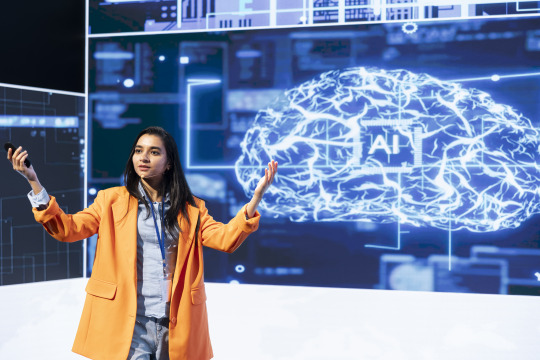
AI's Role in Data Center Energy Management
Data centers are the backbone of the digital world, supporting everything from cloud computing to artificial intelligence. However, their vast energy requirements contribute significantly to operational costs and environmental impact. As the demand for data processing grows, energy management becomes a critical challenge for data center operators.
Artificial Intelligence (AI) is emerging as a game-changer in this domain. By analyzing data in real-time, predicting power usage, and automating energy-saving processes, AI-driven solutions can optimize energy efficiency and reduce the carbon footprint of data centers. This blog explores how AI improves energy efficiency, predicts power usage, tools that utilize AI for energy management, and the environmental and business benefits of AI-driven solutions.
How Does AI Improve Energy Efficiency in Data Centers?
Data centers consume enormous amounts of energy, with cooling systems alone accounting for 30-50% of total energy usage. AI technologies are helping to optimize energy consumption by providing real-time insights, automating operations, and enhancing resource allocation.
1. Dynamic Cooling Optimization
AI continuously monitors temperature, humidity, and airflow within the data center.
Tools like Google’s DeepMind AI optimize cooling by adjusting fan speeds, chillers, and air conditioning in real time, achieving energy savings of up to 40%.
2. Resource Allocation
AI dynamically distributes workloads across servers to minimize power consumption.
Idle servers are powered down or put into low-power modes when not in use.
3. Predictive Analytics
AI predicts energy demands based on historical and real-time data, allowing data centers to adjust power distribution proactively.
Predictive models reduce energy waste by ensuring resources are only used when necessary.
4. Automated Energy Management
AI systems automate energy-intensive tasks, such as workload balancing and capacity planning, reducing manual intervention and inefficiencies.
Can AI Predict Power Usage in Data Centers?
Yes, AI can predict power usage in data centers with high accuracy by analyzing historical data, current operating conditions, and workload patterns. Predicting power usage helps operators make informed decisions to optimize energy consumption and plan for future needs.
1. Machine Learning Models
AI systems use machine learning algorithms to forecast power usage trends based on past data.
These models account for variables such as server load, cooling requirements, and seasonal temperature fluctuations.
2. Real-Time Monitoring
IoT sensors embedded in servers and cooling systems provide continuous data on energy consumption.
AI processes this data to predict short-term and long-term power requirements.
3. Anomaly Detection
AI detects anomalies in power usage patterns, which might indicate inefficiencies or equipment malfunctions.
Example: A sudden spike in power usage could suggest a failing cooling unit that needs immediate attention.
4. Benefits of Predictive Power Management
Prevents energy over-provisioning.
Ensures sufficient power availability during peak workloads.
Reduces costs associated with unexpected energy demands.
What Tools Use AI for Energy Management in Data Centers?
Several tools and platforms leverage AI to enhance energy management in data centers. These tools integrate real-time monitoring, analytics, and automation to optimize energy usage and reduce environmental impact.
1. Google DeepMind
Functionality: Uses AI to optimize cooling systems in Google’s data centers, achieving a 15% improvement in energy efficiency.
Impact: Reduced energy consumption and operational costs without compromising performance.
2. Nvidia Clara
Functionality: Combines AI with IoT sensors to monitor and manage energy consumption in data centers.
Impact: Enhances workload distribution and power usage efficiency.
3. Schneider Electric EcoStruxure
Functionality: An AI-powered platform that offers real-time monitoring, predictive maintenance, and energy optimization.
Impact: Reduces operational costs and supports sustainability goals.
4. IBM Watson
Functionality: Uses AI to analyze energy consumption patterns and predict future requirements.
Impact: Optimizes power allocation and identifies areas for energy savings.
5. Microsoft Project Natick
Functionality: Uses AI to manage energy and cooling systems in underwater data centers.
Impact: Demonstrates the potential of innovative cooling techniques combined with AI.
How Does AI Reduce the Carbon Footprint of Data Centers?
Data centers are responsible for approximately 1% of global energy consumption and contribute significantly to carbon emissions. AI helps mitigate this environmental impact through efficient energy management and resource optimization.
1. Energy Efficiency
AI reduces energy consumption by optimizing cooling systems and workload distribution, lowering the overall carbon footprint.
2. Integration with Renewable Energy
AI integrates renewable energy sources like solar and wind power into data center operations.
Predictive analytics ensure that energy-intensive tasks are scheduled during periods of high renewable energy availability.
3. Reduced Waste
By predicting energy demands, AI prevents over-provisioning, minimizing energy waste and its associated emissions.
4. Sustainable Cooling Solutions
AI-enabled systems use innovative cooling methods like immersion cooling and liquid cooling to reduce energy usage and environmental impact.
5. Carbon Accounting
AI tracks and analyzes carbon emissions from data center operations, helping operators meet sustainability targets and comply with regulations.
Case Study:
Google uses AI to run its data centers on 90% carbon-free energy, setting a benchmark for sustainable operations.
What Are the Benefits of AI-Driven Energy Management?
The benefits of AI-driven energy management extend beyond cost savings, offering significant operational and environmental advantages.
1. Cost Savings
AI reduces energy consumption, which accounts for a significant portion of data center operating expenses.
Automated systems reduce labor costs associated with manual energy management.
2. Improved Uptime
Predictive analytics ensure that power and cooling systems operate efficiently, reducing the risk of downtime caused by overheating or power failures.
3. Scalability
AI systems adapt to the growing demands of data centers, ensuring efficient energy management as workloads increase.
4. Enhanced Sustainability
AI helps data centers align with global sustainability goals by reducing energy waste and carbon emissions.
Supports green certifications like LEED and ISO 50001.
5. Competitive Advantage
Businesses using AI-driven energy management can reduce operational costs, reinvesting savings into innovation and growth.
What Are the Challenges of Implementing AI for Energy Management?
While the benefits of AI-driven energy management are significant, implementation comes with challenges:
1. High Initial Investment
Deploying AI systems requires significant investment in sensors, software, and hardware.
2. Data Privacy Concerns
Real-time monitoring generates vast amounts of data, raising concerns about data security and privacy.
3. Technical Expertise
Operating AI-powered energy management systems requires skilled personnel with expertise in machine learning and energy systems.
4. Integration Complexity
Integrating AI systems with existing data center infrastructure can be complex and time-consuming.
Conclusion:
The integration of AI in data center energy management is revolutionizing how facilities operate, ensuring they are more efficient, reliable, and sustainable. By optimizing cooling systems, predicting energy usage, and reducing waste, AI not only lowers operational costs but also helps combat climate change by reducing carbon emissions.
As businesses face increasing pressure to meet sustainability goals and reduce costs, AI-driven energy management emerges as an indispensable tool for the data centers of the future. For operators looking to stay competitive and eco-friendly, adopting AI solutions is no longer a luxury but a necessity.
Frequently Asked Questions
How Does AI Improve Energy Efficiency in Data Centers?
AI improves energy efficiency by optimizing cooling systems, balancing workloads, and automating energy-intensive tasks.
Can AI Predict Power Usage in Data Centers?
Yes, AI uses machine learning algorithms and real-time data to accurately predict power usage, enabling proactive energy management.
What Tools Use AI for Energy Management in Data Centers?
Tools like Google DeepMind, Schneider Electric EcoStruxure, and IBM Watson use AI to optimize energy consumption and improve efficiency.
How Does AI Reduce the Carbon Footprint of Data Centers?
AI reduces energy waste, integrates renewable energy sources, and supports sustainable cooling solutions to lower carbon emissions.
What Are the Benefits of AI-Driven Energy Management?
Benefits include cost savings, improved uptime, enhanced sustainability, scalability, and competitive advantage.
0 notes
Text
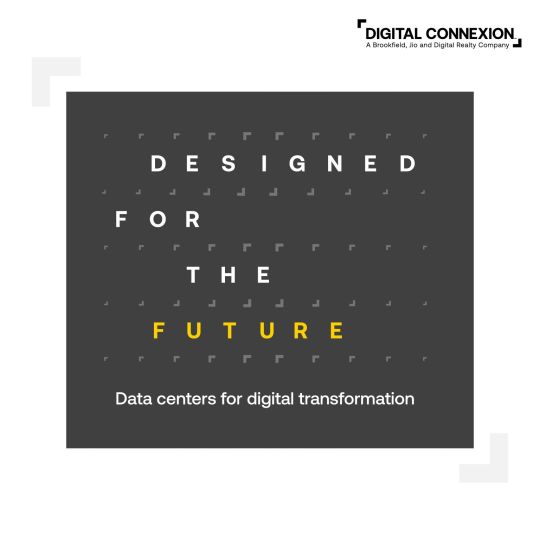
Data Centers for Digital Transformation | Digital Connexion
At Digital Connexion, our resilient and reliable infrastructure is designed to support your digital transformation, enabling seamless growth and collaboration. Let's build a future that's connected, innovative, and full of possibilities.
0 notes
Text
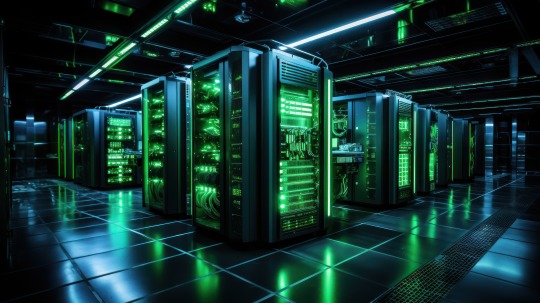
Immersion Cooling Systems: Revolutionizing Data Center Efficiency
As the world’s reliance on data continues to grow, the need for efficient and sustainable cooling solutions in data centers has become more critical than ever. Traditional air-based cooling systems are often energy-intensive and less efficient for handling high-density workloads. This is where immersion cooling systems step in, offering a revolutionary way to cool data centers efficiently while significantly reducing energy consumption.
In this blog, we explore what immersion cooling systems are, their advantages, the challenges they address, and why they are shaping the future of data center technology.
What is Immersion Cooling in Data Centers?
Immersion cooling is a cutting-edge cooling technology where servers are submerged in a thermally conductive, non-electrically conductive liquid. This liquid absorbs the heat generated by the servers, keeping them at optimal operating temperatures.
Unlike traditional air-based cooling, immersion cooling eliminates the need for fans, air conditioning units, or raised floors, making it far more efficient and environmentally friendly.
Types of Immersion Cooling Systems
Single-Phase Immersion Cooling:
The servers are submerged in a cooling liquid that remains in its liquid state. Heat is transferred to the liquid, which is then cooled via external heat exchangers.
Two-Phase Immersion Cooling:
A dielectric liquid boils as it absorbs heat from the servers. The vapor is condensed back into liquid form, creating a self-sustaining cooling cycle.
Why is Cooling Critical in Data Centers?
Data centers house thousands of servers that generate significant amounts of heat during operation. Efficient cooling is essential to:
Prevent Overheating: Ensures servers operate within optimal temperature ranges to avoid performance degradation or hardware failure.
Enhance Energy Efficiency: Cooling consumes nearly 40% of a data center's total energy usage. Efficient cooling systems can dramatically lower energy consumption.
Support High-Density Workloads: With the rise of AI, machine learning, and high-performance computing (HPC), traditional cooling systems struggle to handle the increased thermal loads.
Advantages of Immersion Cooling Systems
1. Energy Efficiency
Immersion cooling systems reduce energy consumption by eliminating the need for air conditioning and fans. Some systems have reported energy savings of up to 50% compared to traditional cooling methods.
2. Higher Server Density
This cooling technology allows for greater server density, as liquid cooling can manage the heat generated by closely packed servers. This is particularly beneficial for applications like AI workloads and blockchain mining.
3. Noise Reduction
Without fans and air-based cooling systems, immersion cooling drastically reduces noise levels in data centers, creating a quieter and more comfortable working environment for on-site personnel.
4. Space Optimization
Immersion cooling systems require less physical space, as there’s no need for large-scale air conditioning units or raised floors. This allows for better utilization of data center real estate.
5. Sustainability
By reducing energy consumption and reliance on air-based cooling, immersion cooling contributes to lower carbon emissions. Some systems also use biodegradable and environmentally friendly cooling liquids.
6. Extended Equipment Lifespan
Servers in immersion cooling systems experience less thermal stress and particulate contamination, potentially extending their operational lifespan.
Applications of Immersion Cooling Systems
High-Performance Computing (HPC)
HPC applications, such as scientific research and financial modeling, benefit from immersion cooling due to their high thermal demands.
Artificial Intelligence (AI) Workloads
AI processing generates intense heat, making immersion cooling ideal for maintaining performance and efficiency.
Blockchain and Cryptocurrency Mining
Immersion cooling is widely used in crypto mining facilities to manage heat from energy-intensive mining rigs.
Edge Data Centers
Compact edge data centers benefit from immersion cooling’s space-saving and energy-efficient design.
5G Infrastructure
As 5G expands, immersion cooling helps manage the increased thermal demands of telecom equipment.
Challenges Addressed by Immersion Cooling
1. High Energy Costs
Traditional cooling systems are energy-intensive. Immersion cooling significantly lowers power usage effectiveness (PUE) by efficiently removing heat.
2. Thermal Limitations
High-density workloads often exceed the capabilities of air-based cooling systems. Immersion cooling ensures consistent thermal management, even for the most demanding applications.
3. Sustainability Concerns
With data centers contributing significantly to global carbon emissions, immersion cooling helps companies meet their sustainability goals by reducing energy consumption and water usage.
What Are the Challenges of Adopting Immersion Cooling?
While immersion cooling offers numerous benefits, its adoption is not without challenges:
High Initial Costs
Implementing immersion cooling systems requires a substantial upfront investment in equipment and retrofitting existing infrastructure.
Limited Awareness
Many organizations are unfamiliar with the technology, creating a barrier to widespread adoption.
Compatibility
Existing hardware may not be fully compatible with immersion cooling systems, requiring custom configurations.
Maintenance
Handling and replacing cooling liquids require specialized expertise and equipment.
Scalability
While immersion cooling is excellent for high-density workloads, scaling the technology for larger facilities can be complex.
Future Trends in Immersion Cooling Systems
Hybrid Cooling Solutions
Combining immersion cooling with traditional methods for tailored solutions based on workload requirements.
AI-Driven Monitoring
Integrating AI tools to monitor liquid temperatures and optimize cooling cycles for maximum efficiency.
Standardization
Development of industry standards for immersion cooling technology to drive adoption and compatibility.
Broader Industry Adoption
As sustainability becomes a global priority, more industries will adopt immersion cooling for its energy-saving benefits.
Advancements in Cooling Liquids
Research is underway to develop biodegradable, cost-effective, and highly efficient cooling liquids.
Conclusion:
Immersion cooling systems are revolutionizing the way data centers manage heat, offering unmatched efficiency, sustainability, and scalability. As industries like AI, blockchain, and 5G demand higher performance, immersion cooling is emerging as a critical solution.
For businesses looking to stay ahead in the digital era, adopting immersion cooling isn’t just a choice—it’s a strategic imperative. With advancements in technology and growing awareness, the future of immersion cooling looks brighter than ever.
FAQs:
What is Immersion Cooling in Data Centers?
Immersion cooling is a technology where servers are submerged in non-conductive liquids to manage heat efficiently. It reduces energy consumption and eliminates the need for traditional air-based cooling.
How Does Immersion Cooling Work?
Immersion cooling works by transferring heat from servers to a liquid medium. The liquid absorbs and dissipates heat, either through single-phase cooling (using heat exchangers) or two-phase cooling (boiling and condensing).
Why is Immersion Cooling Better than Traditional Methods?
Immersion cooling is more energy-efficient, supports high-density workloads, reduces noise, and eliminates the need for large air conditioning systems, making it superior to traditional methods.
Which Companies Use Immersion Cooling?
Leading companies like Microsoft, Google, and Alibaba are investing in immersion cooling to optimize their data centers' performance and sustainability.
What are the Costs of Implementing Immersion Cooling?
While initial costs can be high due to equipment and retrofitting, immersion cooling offers long-term savings in energy consumption and maintenance.
0 notes
Text
MAA10 Chennai: Intelligent Solutions for Seamless Business Operations
At MAA10 Chennai, every corner is equipped for smarter, faster responses. With intelligent systems, real-time insights, and seamless global integration, we’re always working to keep your business running smoothly and securely.
0 notes
Text
Data Center in Chennai | Digital Connexion
MAA10 Chennai, our greenfield data center is built to the highest environmental standards. This state-of-the-art facility combines clean energy solutions, optimized design, and advanced waste management, all within a scalable infrastructure.
0 notes
Text
Data Center in Chennai | Digital Connexion
MAA10 Chennai features a sophisticated design with advanced systems to ensure maximum uptime and safety. From modular UPS architecture to robust cooling, every element is optimized for reliability and efficiency.
0 notes
Text
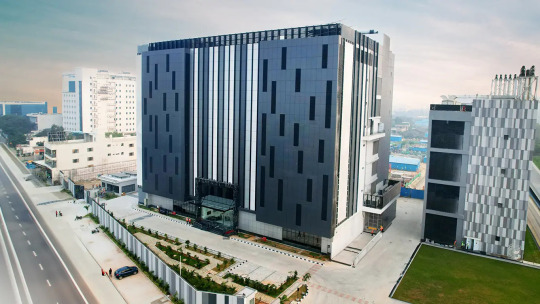
Explore Advanced Data Center in Chennai with Digital Connexion
At Digital Connexion, we harness India's unique geographical location and proximity to countries with great potential for growth and we offer a gateway to unlock limitless potential for your business. Our data center in Chennai and Mumbai fulfill your colocation requirements with interconnections that are primed to provide your enterprise with unlimited global opportunities.
0 notes
Text

Elevate Your Infrastructure: Data Center Services by Digital Connexion
Redefine excellence with Digital Connexion's data center services. Elevate your infrastructure to new levels of performance and reliability, supported by our unmatched expertise and dedication to your success.
0 notes
Text
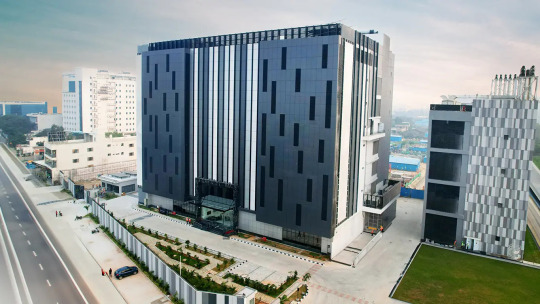
Optimize Your Operations with a Data Center in Chennai
Drive efficiency and scalability with Digital Connexion's data center in Chennai. Our advanced infrastructure empowers businesses to optimize their operations and accelerate growth. Experience seamless connectivity and unparalleled support with Digital Connexion's data center solutions in Chennai.
0 notes
Text
BOM 10 - Data Center In Mumbai
BOM10 - Designed for exponential growth Our Mumbai data center offers access to multiple submarine cable landing stations, and a carrier-dense ecosystem, for business-critical enterprises
For more info visit: https://digitalconnexion.com/
0 notes